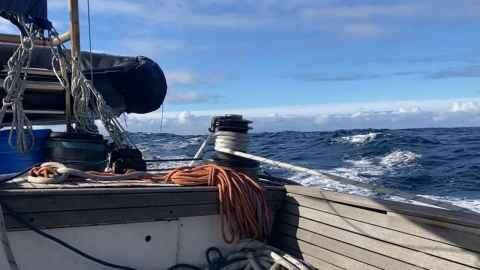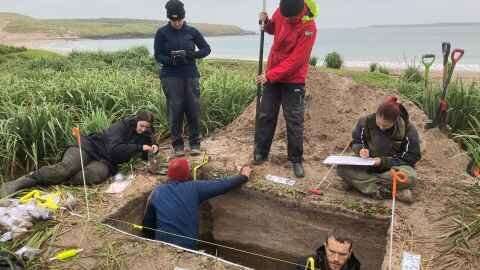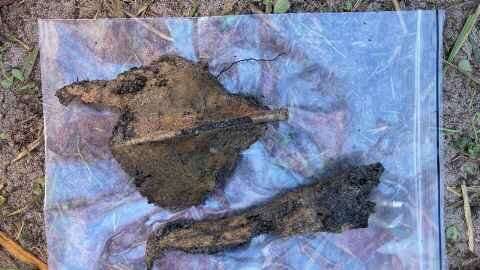This article has been reviewed according to Science X's editorial process and policies. Editors have highlighted the following attributes while ensuring the content's credibility:
fact-checked
trusted source
proofread
Intrepid southern voyage in the wake of early waka

A recent expedition by an archaeology team from the Universities of Auckland and Canterbury to Enderby in the Auckland Island archipelago plans to answer remaining questions about Māori voyaging and life on the island dating back to 1400 CE.
A team of 12, led by Professors Thegn Ladefoged and Simon Holdaway from the University of Auckland, Dr. Matiu Prebble (University of Canterbury) and Dr. Gerard O'Regan (Ngāi Tahu) from the Tūhura Otago Museum, spent 11 days on Enderby in April, looking for further evidence of early human interactions with the landscape.
Around half of the crew were Ngāi Tahu archaeologists or students.
Previous research on the island, carried out nearly 20 years ago by Ngāi Tahu archaeologist Professor Athol Anderson, had established Māori had been on Enderby and survived on its abundant bird and marine mammal life, so the team were keen to revisit areas that had already been excavated with state-of-the-art equipment to see what more could be discovered.
Before even setting foot on the island, the group had to observe strict quarantine protocols as the island is a Department of Conservation-protected wildlife sanctuary, says Professor Holdaway.
"We had to have everything washed and sterilized before we left, even down to things that were stuck in Velcro."
The team were then driven in a decontaminated van to the wharf at Bluff where they loaded the large amount of gear (including a vibracore, the latest sediment-sampling technology used to take undisturbed cores of sediment from wet environments) needed on to sailing vessel Evohe, as well as nearly two weeks' worth of supplies and clothing for extreme weather.
The journey was so rough going over the Foveaux Strait, they had to "hole up" on Stewart Island for the night and most of the next day, says Holdaway. They then made use of favorable winds to head to Enderby, another nearly two days across the notorious Southern Ocean.
"We had to sit out the back in the cockpit near the wheelhouse or risk being washed away. Safety harnesses and a whole bunch of gear were needed on deck, which was only for experienced crew."
And while there were definitely some green faces during the voyage, he says, the best part was approaching the island.
"You see birds starting to arrive around the yacht and this big cloud sitting over the Auckland Islands, which is what Māori must have seen as they arrived in their waka. [Emeritus Professor of Anthropology] Geoffrey Irwin talks about the indications of landfall before you actually see land, and that's what we saw … a big cheer went up!"
Enderby, at the northern end of the Auckland Island archipelago, is a relatively low island compared to the main islands, which are higher and volcanic in origin, and were glaciated in the Pleistocene era (c. 2.58 million to 11,700 years ago, including the last ice age), says Holdaway.
"Enderby is really exposed to the westerly winds on the western edge, but the opposite side gets the south easterly and has a bay with a sandy beach, Sandy Bay, the only one on the island, which is where we went ashore at the rocky end to avoid trying to land gear in big surf."

The team had been warned not to disturb the large colony of sea lions on the beach or bother the yellow-eyed penguins that make their way to the sea in the morning and return across the sand to sleep in the afternoon.
"It wasn't sea lion breeding season but there was a colony on the beach every day sunning themselves. We were really clear that animals have priority on these islands, so we did a lot of avoidance, which at times was not easy."
The marine bird life—skuas, nellies (giant petrels), albatrosses—was also abundant.
"All these creatures are what we call 'naive fauna' in that they've had very little contact with humans, so they're not particularly worried about us. You'd have seabirds floating right above your head, just having a look at you!"
Holdaway says they did have one afternoon, during a walk across the island, where they saw several albatrosses perched on the ground as they passed, unconcerned.
He says two previous trips made by archaeologists, in the late 1990s and early 2000s, hadn't been able to undertake extensive excavations because of limited time, with one of the trips cut short by bad weather, so the team already had a plan of attack.
"Those teams roughly plotted where they'd been because they didn't have access to the latest surveying technology, and we were pretty careful about checking the maps they'd made and figuring out where they'd been before."
During their 11 days on the island the team mostly focused on excavations in areas already exposed by rabbit, cattle and seal erosion, which were at risk of being washed away.
And while they won't be certain of their findings until after all their samples are analyzed in the lab, they did find extensive evidence for earth ovens and more extended occupation.
"There were areas of eroding midden—animal bone, charcoal and fire cracked rock—where we excavated and took samples," says Holdaway.
"And we also found a number of fire pits associated with animal remains; the sort of animal bones you'd expect from albatrosses and large sea mammals like sea lions."
He says the exciting finds—evidence of materials transported from mainland Aotearoa, if these are present—will come from detailed laboratory analysis of the material brought back from the excavations, with this work now underway.
Led by Dr. Prebble, the team used the vibracore to push down into the soft sand and recovered ten cores of sediment containing seeds and pollen from a depth of up to three meters. The cores are currently being analyzed in Christchurch and will provide a detailed record of vegetation change and Māori activity.

Working in the field is very labor intensive, says Holdaway.
"It's physically hard in the sense that you're digging out sediment, passing it through a sieve to sort out the finer material to reduce the volume, and then individually bagging it all up. You're lifting buckets of sand all day, every day. I usually spend a period in the gym ahead of any trip just building up enough strength to get through it."
At least a couple of hours after the field work is finished each day is spent cataloging finds.
The team ultimately want to confirm the chronology established by Professor Anderson's team, who found radiocarbon dates of around 1400, as well as any evidence for later Māori occupations before Europeans arrived in the 19th century.
"Finding evidence of early human occupation on the Aucklands is amazing in itself. It's a fair way down and the people that took the waka down there absolutely knew what they were doing and made good use of the animal resources," says Holdaway.
"We knew that before, but the extent of it was pretty impressive. Key finds will be how old the samples are and if there is evidence for reoccupation, which wouldn't be unexpected given the abundance of wild resources."
"Archaeology is all about data management. You do everything in the field you can to be absolutely sure you know what you've picked up, because you can't go back if you've left anything behind," says Holdaway
All the data from the total stations (modern surveying equipment) is downloaded each night and the computer database is created using those instrument readings.
And the constant backdrop to all the work, the weather, while not actually freezing, was still brisk, he says.
"When the weather's nice on Enderby, it's really nice. We were lucky, it didn't rain until the last day. I would say it was cool to cold. The analogy for trampers would be somewhere like Fiordland in the late autumn or early spring; we needed three or four layers, plus hats and gloves."
At one point, supplies got a little thin when a group were based on the island longer than planned as Evohe had to move out of the bay due to the weather.
"You need to be good at cooking as an archaeologist," laughs Holdaway, "especially on remote projects; you have to be able to look after the crew and put a dinner together out of cans or packets. You're feeding hungry people who have been working hard all day. We made Italian one night, that was quite fun."
Despite the intensity and challenge of the field work, most of the work is actually done back in the lab, says Holdaway.
"Talk to almost any archaeologist and they will say you have to spend five to 10 times the period in the lab that you've spent in the field."
Provided by University of Auckland


















